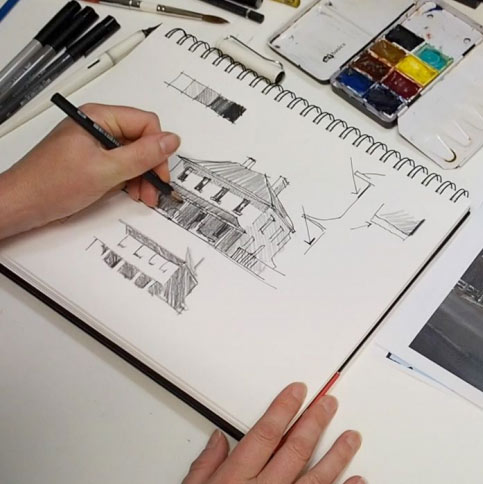 (Burj Khalifa, Dubai; photo retrieved from Khaleej Times)
(Burj Khalifa, Dubai; photo retrieved from Khaleej Times)
A beautiful, purposeful building can be as striking and inspiring as any artistic masterwork. It’s easy to be drawn to a field with as much creative freedom, and ability to touch communities, as architecture. But it can be a hard-fought battle to become a successful architect; it may even take several decades.
Architects tend to be late bloomers. It takes years of practice, study, and self-refinement to get accredited, let alone to distinguish yourself from others once you’ve become an architect proper. If you aspire to be an architect, it’s important to be prepared early; a little bit of knowledge goes a long and powerful way in helping you avoid some of the pitfalls on this long, challenging, yet extremely rewarding journey.
1. Understand how architecture intersects with other fields.
Architects are the creative masterminds behind some of our biggest projects. Because of the scope and scale of these projects, they necessarily interact with many other groups of professionals. Understanding how architecture intersects with other areas will unlock a deeper understanding of the architect’s role. You’ll also better understand the desires, expectations, and needs of other stakeholders.
Talent, creativity, and hard work are clearly important to the architect. Just as important to completing any project is the architect’s ability to have productive and meaningful interactions with bureaucrats, engineers, industrial designers and planners, lawyers, investors, and many others who have a key role in the planning, zoning, and execution of a project.
If you’re considering applying to an architecture program, it’s important to remember that it’s extremely common for undergraduates to change majors. If, like many, you realize that your degree program is not for you, a thorough understanding of the roles and professions that intersect with your interests will help you transition gracefully; perhaps you’ll discover that you had subconsciously wished to be an industrial designer or civil engineer all along!
2. Start early and develop successful habits.
 (Sketching a house; photo retrieved from sketchingnow.com)
(Sketching a house; photo retrieved from sketchingnow.com)
While this is good advice for everyone, it’s especially true for architects. Architecture is a field that demands a great deal of commitment and persistence over time. You must hone essential creative and technical skills, find the right school for you, and gain essential workplace experience before you can think about getting accredited.
It’s important to record and express your ideas in sketches and in written form; it’s especially prudent to carry a sketchbook. Pradeep Attri emphasizes that aspiring architects are wise to master pencil and paper before moving on to higher-tech tools like Autocad or Photoshop.
3. Find the right program.
If you wish to study architecture, you must pick the right accredited architecture school for your individual needs as a student. The Association of Collegiate Schools of Architecture lists 127 American and 11 Canadian schools as having accredited architecture programs. They likewise list 800 US institutions as having programs either in architecture, or in related fields including urban planning and real estate development.
This may sound like a lot, but the NCES in 2013-14 listed 3,039 four-year colleges in the United States, and 4,724 total degree-granting institutions. Schools offering accredited architecture programs thus only comprise a small fraction of American colleges.
 (Laurentian University’s McEwen School of Architecture; photo retrieved from laurentian.ca)
(Laurentian University’s McEwen School of Architecture; photo retrieved from laurentian.ca)
Research as much as you can about the application process, and what the programs to which you are applying generally expect from applicants. Shelley Little reminds us that many programs prioritize students who have strong mathematics backgrounds, and may have pursued summer internships or similar programs already.
Before you apply to your school of choice, know the time commitment you are making! Michael Bunch, in his 1993 dissertation, estimated that one should expect to take at least thirteen years to become a successful architect. This includes an estimated five or six years in school, as well as at least three years in professional placement programs and internships. Internships are key to aspiring architects; this cannot be overstated.
Aspiring architects would also be well wise to prepare for jury reviews, both intellectually and psychologically. Having your work evaluated, probed, even attacked by peers and mentors can be difficult, but architect Bob Borson offers some practical advice for stressed students: understand the big concept behind your project; differentiate between reasons and excuses (prepare the former, not the latter!); remember that critiques are professional, rather than personal - you are not your work!; keep in mind that jurors are fallible, too.
4. Understand key movements
 (Rome’s Trevi Fountain; photo retrieved from architecturaldigest.com)
(Rome’s Trevi Fountain; photo retrieved from architecturaldigest.com)
Earlier, you read about the other professionals that architects interact with throughout the course of a project. Art and art history are no exception; an architectural project is a reflection of the artistic paradigm in which it was conceived.
Thus, it’s important to learn about everything from the classical architecture that inspired Romanesque architecture at the turn of the millennia to the Gothic architecture that still typifies our vision of the medieval aesthetic today. Renaissance architecture, in the same way, gave way to Baroque and eventually the flamboyant rococo movement. Gothic revivalism was similarly a cornerstone of Victorian architecture.
Today, architects and artists alike experiment with modernism, postmodernism, structuralism, and other distinctive contemporary styles, while still drawing inspiration from the rich European tradition.
These movements in architecture not only corresponded with shifting artistic tastes, but also social changes, like the shift away from religious architecture as the necessarily dominant form. Material considerations are similarly important; historically, architects had to work with whichever natural materials were at hand. Today, steel construction and glass facades are ubiquitous.
5. Work on your soft skills.
 (Young architects collaborating; photo retrieved from fthmb.tqn.com)
(Young architects collaborating; photo retrieved from fthmb.tqn.com)
You can probably name at least a half-dozen technical skills that architects depend on, like sketching, logic and problem solving, and mathematics. Just as important are soft skills, like being able to pitch ideas to others, explain intricate ideas in simple and concise terms, and being able to share cramped co-working spaces without issues.
Hajira Qazi stresses the importance of bonding with teachers and mentors; not only will this help you get references later on, but by having a good working relationship, you’ll get the most out of their feedback.
6. Travel widely, and with open eyes.
 (Kölner Dom in Cologne, Germany; photo retrieved from koelner-dom.de)
(Kölner Dom in Cologne, Germany; photo retrieved from koelner-dom.de)
Architects have come up with some very creative solutions to both uniquely local and more universal design problems. Traveling offers new insight about how things can be done; you’ll invariably be exposed to something you’ve never seen before. It doesn’t matter if you’re sketching the skylines of iconic metropoles like New York or Chicago, or are awestruck by the living history of the Kölner Dom or the Bibi-Khanyim Mosque. Traveling allows you to discover new approaches and ideas while immersing yourself in the culture they originate from.
 (Bibi-Khanym Mosque, Samarkand, Uzbekistan; photo retrieved from alluringworld.com)
(Bibi-Khanym Mosque, Samarkand, Uzbekistan; photo retrieved from alluringworld.com)
7. Stand on the shoulders of giants
 (Frank Gehry, photographed by Jonas Fredwall Karlsson; photo retrieved from Vanity Fair)
(Frank Gehry, photographed by Jonas Fredwall Karlsson; photo retrieved from Vanity Fair)
Architects have an opportunity to leave an indelible mark on the world around them. Some architects build a sufficiently notable legacy to become icons in their own right. Architects from Frank Gehry to Phil Kean have built loyal followings both within their discipline and within their communities at large. Every master architect has his or her own set of lessons to impart to the next generation.
 (Phil Kean, Architect, AR95091)
(Phil Kean, Architect, AR95091)